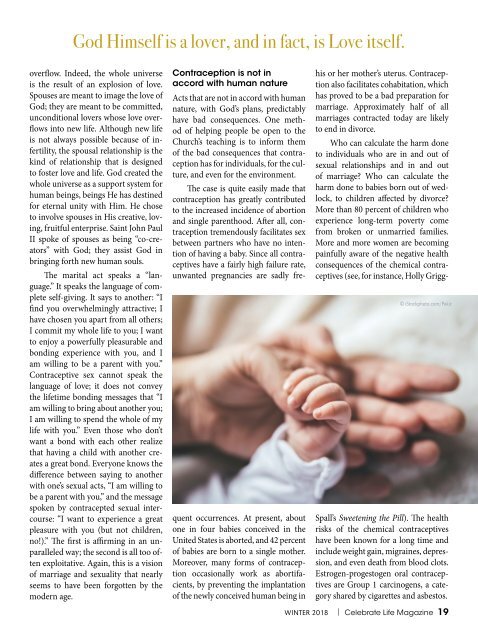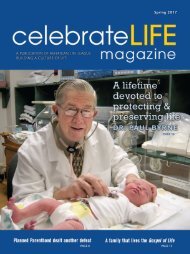Celebrate Life Magazine - Winter 2018
The winter 2018 issue of Celebrate Life Magazine contains "The end of neutrality" by Terrell Clemmons, "Pro-life essay winners," "Humane Vitae's golden anniversary" by Janet E. Smith, PhD, "Priceless value the world does not see" by Lori Hatcher, and "Seven suggestions for recognizing the personhood of the preborn" by Evelyn French
The winter 2018 issue of Celebrate Life Magazine contains "The end of neutrality" by Terrell Clemmons, "Pro-life essay winners," "Humane Vitae's golden anniversary" by Janet E. Smith, PhD, "Priceless value the world does not see" by Lori Hatcher, and "Seven suggestions for recognizing the personhood of the preborn" by Evelyn French
Create successful ePaper yourself
Turn your PDF publications into a flip-book with our unique Google optimized e-Paper software.
God Himself is a lover, and in fact, is Love itself.<br />
overflow. Indeed, the whole universe<br />
is the result of an explosion of love.<br />
Spouses are meant to image the love of<br />
God; they are meant to be committed,<br />
unconditional lovers whose love overflows<br />
into new life. Although new life<br />
is not always possible because of infertility,<br />
the spousal relationship is the<br />
kind of relationship that is designed<br />
to foster love and life. God created the<br />
whole universe as a support system for<br />
human beings, beings He has destined<br />
for eternal unity with Him. He chose<br />
to involve spouses in His creative, loving,<br />
fruitful enterprise. Saint John Paul<br />
II spoke of spouses as being “co-creators”<br />
with God; they assist God in<br />
bringing forth new human souls.<br />
The marital act speaks a “language.”<br />
It speaks the language of complete<br />
self-giving. It says to another: “I<br />
find you overwhelmingly attractive; I<br />
have chosen you apart from all others;<br />
I commit my whole life to you; I want<br />
to enjoy a powerfully pleasurable and<br />
bonding experience with you, and I<br />
am willing to be a parent with you.”<br />
Contraceptive sex cannot speak the<br />
language of love; it does not convey<br />
the lifetime bonding messages that “I<br />
am willing to bring about another you;<br />
I am willing to spend the whole of my<br />
life with you.” Even those who don’t<br />
want a bond with each other realize<br />
that having a child with another creates<br />
a great bond. Everyone knows the<br />
difference between saying to another<br />
with one’s sexual acts, “I am willing to<br />
be a parent with you,” and the message<br />
spoken by contracepted sexual intercourse:<br />
“I want to experience a great<br />
pleasure with you (but not children,<br />
no!).” The first is affirming in an unparalleled<br />
way; the second is all too often<br />
exploitative. Again, this is a vision<br />
of marriage and sexuality that nearly<br />
seems to have been forgotten by the<br />
modern age.<br />
Contraception is not in<br />
accord with human nature<br />
Acts that are not in accord with human<br />
nature, with God’s plans, predictably<br />
have bad consequences. One method<br />
of helping people be open to the<br />
Church’s teaching is to inform them<br />
of the bad consequences that contraception<br />
has for individuals, for the culture,<br />
and even for the environment.<br />
The case is quite easily made that<br />
contraception has greatly contributed<br />
to the increased incidence of abortion<br />
and single parenthood. After all, contraception<br />
tremendously facilitates sex<br />
between partners who have no intention<br />
of having a baby. Since all contraceptives<br />
have a fairly high failure rate,<br />
unwanted pregnancies are sadly frequent<br />
occurrences. At present, about<br />
one in four babies conceived in the<br />
United States is aborted, and 42 percent<br />
of babies are born to a single mother.<br />
Moreover, many forms of contraception<br />
occasionally work as abortifacients,<br />
by preventing the implantation<br />
of the newly conceived human being in<br />
his or her mother’s uterus. Contraception<br />
also facilitates cohabitation, which<br />
has proved to be a bad preparation for<br />
marriage. Approximately half of all<br />
marriages contracted today are likely<br />
to end in divorce.<br />
Who can calculate the harm done<br />
to individuals who are in and out of<br />
sexual relationships and in and out<br />
of marriage? Who can calculate the<br />
harm done to babies born out of wedlock,<br />
to children affected by divorce?<br />
More than 80 percent of children who<br />
experience long-term poverty come<br />
from broken or unmarried families.<br />
More and more women are becoming<br />
painfully aware of the negative health<br />
consequences of the chemical contraceptives<br />
(see, for instance, Holly Grigg-<br />
© iStockphoto.com/Pekic<br />
Spall’s Sweetening the Pill). The health<br />
risks of the chemical contraceptives<br />
have been known for a long time and<br />
include weight gain, migraines, depression,<br />
and even death from blood clots.<br />
Estrogen-progestogen oral contraceptives<br />
are Group 1 carcinogens, a category<br />
shared by cigarettes and asbestos.<br />
WINTER <strong>2018</strong> | <strong>Celebrate</strong> <strong>Life</strong> <strong>Magazine</strong> 19





